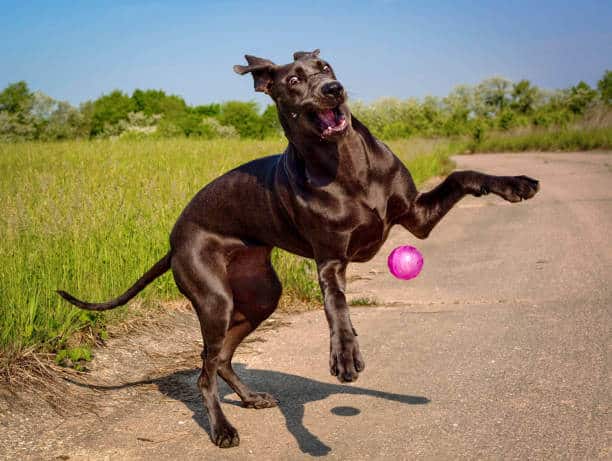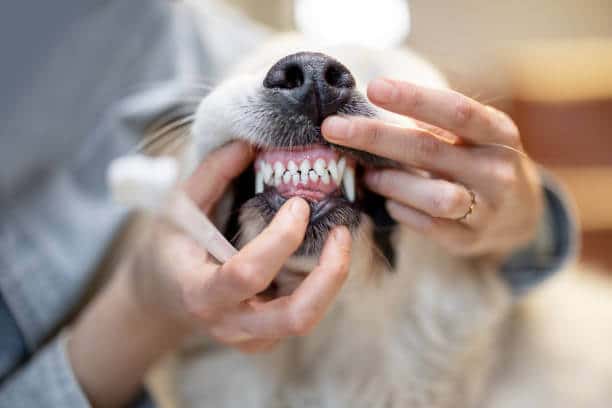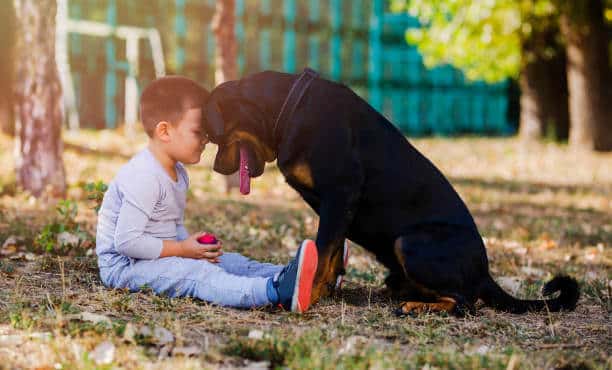Attention all dog lovers, today is your lucky day because we have dug up answers to 22 of the most pressing dog lover questions you might have!
Have you ever wondered why your furry friend tilts their head when you speak to them? Or maybe you’re curious about why your pooch prefers one type of toy over another. Well, we’re here to answer all of your burning questions with some pawsome knowledge!
This blog post will delve deep into the canine world and answer 22 of the most common dog questions. We’ve got you covered, from their adorable head tilts to their love of chasing their tails. But don’t worry; this won’t be a “ruff” read. We’ll throw in some witty humor along the way to ensure your tail is wagging as much as your pup’s. So sit, stay, and get ready to learn some new tricks about man’s best friend.
Why Having A Dog Is Better Than A Cat?

As a proud dog lover, I can say without a doubt that having a dog is better than having a cat. Now, before you feline enthusiasts start hissing at me, let me explain why.
First and foremost, dogs are the ultimate companions. They are always eager to greet you with wagging tails and sloppy kisses when you come home. Conversely, cats might acknowledge your existence with a quick glance before resuming their nap on the windowsill.
But it’s not just about the warm welcomes – dogs are also great motivators. They’ll never let you skip a walk or a run, no matter how lazy you might feel. And let’s be real; we could all use a little extra motivation to stay active and healthy.
Dogs also have a unique ability to sense our emotions and provide us with comfort when we’re feeling down. They’re always there to lend an ear (or a paw) and offer unconditional love and support. Cats, on the other hand, might just stare at you with a judgmental look, wondering why you’re not feeding them on time.
And let’s not forget about their natural protective instincts – dogs are loyal to their humans and will go to great lengths to protect them. Can you imagine a cat doing that? They’d probably just run away and hide under the bed.
Lastly, let’s talk about the fun factor. Dogs are always down for a game of fetch or a romp in the park. They’re constantly making us laugh with their silly antics and goofy expressions. Cats, on the other hand, are more likely to judge us for finding humor in their presence.
So, to sum it up, having a dog is better than having a cat because they are loving companions, motivating workout buddies, emotional support animals, protective guardians, and just plain fun to be around. Sorry, cats – maybe next time.
This is my big girl and the ruler of my house, Saffron!

Why Do Dogs Bury Bones?
Dogs bury bones for several reasons, some dating back to their wild ancestry. In the wild, dogs would often bury their food to save it for later, as they never knew when they would find their next meal. This behavior is still present in many dogs today, even though they now live in homes where food is readily available.
Another reason dogs bury bones is to hide them from other animals or even humans. Dogs are territorial creatures, and they may feel the need to protect their food and toys from potential threats. By burying their bones, they are stashing them away in a secret spot where they feel they can keep them safe.
Burying bones may also be a way for dogs to satisfy their natural instincts to dig. Digging and burying things is a natural behavior for dogs, and many find it enjoyable. By burying their bones, dogs are fulfilling this innate urge to dig.
Finally, some dogs may bury their bones simply because they don’t want them at the moment. Dogs can be finicky creatures, and just like humans, they may not always be in the mood for a certain type of food or treat. By burying their bones, they can return to them later when they are in the mood for a tasty snack.
So, the next time you catch your furry friend digging up your garden to bury their bone, don’t be too upset – it’s just their natural instinct kicking in. Just ensure they don’t bury your car keys while they’re at it!
Why Do Dogs Chew?

Ah, the age-old question: why do dogs love to chew? As a dog lover, I can tell you that there are actually several reasons why dogs love to chomp on things.
First and foremost, chewing is a natural instinct for dogs. In the wild, dogs would chew on bones and other objects to help keep their teeth clean and their jaws strong. Even though our furry friends now have access to dental chews and toothbrushes, their instinct to chew remains.
Chewing is also a great way for dogs to relieve stress and anxiety. Just like some humans might turn to comfort food or stress balls when they’re feeling tense, dogs will often turn to chewing to cope with their emotions. Chewing releases endorphins in the brain, which can help dogs feel calmer and more relaxed.
Another reason dogs love to chew is that it helps with teething. Puppies especially have a strong urge to chew when their adult teeth are coming in. Chewing can help alleviate the discomfort and pain of teething.
But as much as we love our furry friends, we don’t always love what they choose to chew on. Shoes, furniture, and even walls are all fair game to a dog who is in the mood for a good chew. So, it’s important to provide them with appropriate chew toys and bones to satisfy their chewing needs and prevent destructive behavior.
In conclusion, dogs chew for various reasons, including instinctual behavior, stress relief, and teething. So, the next time you catch your pup gnawing on something they shouldn’t be, don’t be too quick to scold them – just redirect their attention to an appropriate chew toy and enjoy the peace and quiet!
Why Dogs Do Zoomies?

Alright, folks, it’s time to talk about one of the most entertaining things dogs do: zoomies. You know, that thing where they run around like a maniac for no apparent reason? It’s like they’re possessed by the spirit of a hyperactive child on a sugar rush.
So, why do dogs do zoomies? Well, the short answer is: because they can. Dogs are creatures of pure joy and energy; sometimes, they just can’t contain it. When they get that burst of energy, they need to let it out somehow, and what better way to do that than by sprinting around the house or yard like a mad dog?
But there’s more to it than just pure joy. Zoomies can also indicate that your dog is feeling particularly happy or excited. Maybe you just got home from work, or maybe they just had a particularly satisfying meal – whatever the reason, sometimes dogs just need to let their excitement out in the form of a good old-fashioned Zoomie session.
Of course, zoomies can also be a sign that your dog is feeling a little bit anxious or stressed. If your pup is suddenly darting around the room like a crazed squirrel, it could be because they feel overwhelmed or overstimulated. In this case, it’s best to give them some space and let them calm down on their own.
But let’s be real – dogs usually do zoomies simply because it’s fun. And honestly, who can blame them? Watching a dog do zoomies is like watching a hilarious comedy movie – it’s impossible not to crack a smile.
So, the next time your dog starts doing zoomies, don’t try to stop them – just sit back and enjoy the show. It’s like free entertainment, courtesy of your furry best friend.
Why Do Dogs Follow You Around?
Do you ever feel like your furry best friend is stalking you? Like, no matter where you go, your dog is always, right behind you? Well, don’t worry, it’s not just you – dogs have a tendency to follow their humans around like, well, a faithful shadow.
So, why do dogs follow you around? The answer is actually quite simple: dogs are pack animals, and they see their humans as part of their pack. In the wild, dogs would always stick together in a pack to hunt and protect each other. When dogs see their humans as part of their pack, they feel the need to stay close to them to ensure their safety and well-being.
Additionally, dogs are incredibly social creatures, and they crave attention and affection from their humans. When they follow you around, they’re not just keeping an eye on you – they’re also hoping for a pat on the head, a scratch behind the ears, or maybe even a treat or two.
But don’t worry; it’s not all about them – dogs also follow their humans around because they simply enjoy being around them. Dogs are loyal and loving creatures who just want to spend time with their favorite humans.
Of course, there are some cases where a dog might follow their human around because they have separation anxiety or some other underlying issue. If you’re concerned that your dog’s following behavior is becoming excessive or disruptive, it’s always a good idea to consult with a veterinarian or a professional dog trainer.
So, the next time you feel like your furry friend is stalking you, just remember – it’s because they love you and want to be close to you. And honestly, who can blame them? Humans are pretty great if we do say so ourselves.
Are Dogs Allowed Pineapple?
Yes, dogs are allowed to eat pineapple in moderation! Pineapple is actually a healthy and tasty treat for our furry friends.
Pineapple contains various beneficial vitamins and minerals for dogs, including vitamin C, vitamin B6, and potassium. It also contains an enzyme called bromelain, which can help improve digestion and reduce inflammation in the body.
That being said, it’s important to feed pineapple to your dog in moderation. Too much pineapple can cause stomach upset or diarrhea, and the high sugar content can also be a problem for dogs with diabetes or weight issues.
Preparing the pineapple properly before giving it to your dog is also important. Make sure to remove the tough outer skin and the hard, fibrous core, as these parts can be difficult for dogs to digest. You can cut the pineapple into small, bite-sized pieces and feed it to your dog as a healthy treat.
As always, it’s a good idea to talk to your veterinarian before introducing any new foods into your dog’s diet, especially if your dog has any pre-existing health conditions. But pineapple can be a great addition to your dog’s diet as a healthy and tasty snack.
Are Dogs Allowed Watermelon?
Ah, watermelon – the ultimate summer fruit. But is it safe for our furry friends to indulge in this juicy treat? As a dog lover, I can tell you that the answer is yes – dogs are allowed to eat watermelon!
In fact, watermelon is a healthy and refreshing snack for dogs, especially on a hot day. It’s low in calories and high in nutrients like vitamins A, B6, and C, as well as potassium and fiber. Plus, the high water content can help keep your dog hydrated, which is always good.
But as with any new food, it’s important to introduce watermelon to your dog in moderation. Too much watermelon can cause digestive issues like diarrhea or upset stomach, and the rind and seeds can also be difficult for dogs to digest.
When feeding watermelon to your dog, make sure to remove the seeds and the rind, as these parts can cause digestive issues or even intestinal blockages. You can cut the watermelon into small, bite-sized pieces and feed it to your dog as a tasty and healthy treat.
It’s also a good idea to keep an eye on your dog while they’re eating watermelon, just to make sure they’re not choking on any seeds or having any other issues. And as always, if you’re unsure whether a certain food is safe for your dog to eat, it’s best to consult your veterinarian.
So, the next time you’re enjoying a juicy slice of watermelon on a hot summer day, feel free to share a bite with your furry friend – just make sure it’s seedless and rind-free!
related article – frozen dog treats for summer
There are two things I love very much in this world, the first one is ice-cream and the second is my dogs. They go with me wherever I go and in the summer that’s usually to the beach. On those hot summer days I will always grab the dog bowls, water and my cooler with … Read The Full Article Here.

Can I Use Human Toothpaste To Brush My Dogs Teeth?
Well, if you want to end up with a toothpaste-covered pup and a bathroom that looks like a crime scene, then sure, go ahead and use human toothpaste to brush your dog’s teeth. But if you want to keep your furry friend’s pearly whites sparkling and healthy, then it’s best to stick with toothpaste specifically designed for dogs.
Here’s the deal: human toothpaste contains many ingredients that can harm dogs if ingested in large quantities. For example, human toothpaste often contains xylitol, a sweetener that can be toxic to dogs and cause a rapid insulin release, leading to hypoglycemia (low blood sugar). Other ingredients like fluoride, detergents, and essential oils can also be harmful to dogs.

Toothpaste made specifically for dogs, on the other hand, is formulated with their unique needs in mind. It’s safe for them to swallow, and it often comes in flavors like chicken or beef, making toothbrushing a more pleasant experience for you and your pup.
So, if you want to keep your dog’s teeth healthy and clean, it’s best to invest in a good-quality dog toothpaste and toothbrush.
In conclusion, when it comes to toothpaste, dogs should stick with the doggie stuff, and humans should stick with the human stuff. Trust us; your dog’s teeth (and your bathroom) will thank you for it!
Are Dogs Color Blind?
Ok, my doggie-loving friends, it’s time to debunk one of the most persistent myths about dogs – are they really colorblind? As a dog lover and amateur myth-buster, I can tell you that the answer is both yes and no.
It’s true that dogs don’t see colors in the same way that humans do. While humans have three types of color receptors (cones) in their eyes that allow us to see a full range of colors, dogs only have two types of cones. This means that they see the world in a more limited range of colors, similar to how a colorblind human would see.
However, this doesn’t mean that dogs see the world in black and white. They can still distinguish between some colors, like blue and yellow, and their vision is actually better suited for seeing things in low light conditions than humans’ vision.
So, while dogs may not be able to appreciate the beauty of a rainbow as we can, they can still see and enjoy the world around them in their own way. Plus, let’s be real, dogs don’t really care about colors anyway – as long as their toys are fun to play with and their food is tasty, they’re happy campers.
In conclusion, while dogs may not be able to see the world in the same range of colors that humans can, they still have their own unique way of seeing and experiencing the world. And at the end of the day, that’s all that matters – because, let’s face it, dogs are too busy living their best lives to worry about colors.
Are Dogs Good For Mental Health?
As a dog lover and someone who has struggled with mental health issues in the past, I can tell you that dogs are not just good for your physical health – they’re also amazing for your mental health. And I’m not just saying that because I’m a crazy dog person (although, let’s be real, I totally am).
There’s scientific evidence to back up the fact that dogs can positively impact mental health. Studies have shown that spending time with dogs can help reduce stress, anxiety, and depression and improve overall mood and well-being. Plus, who can resist those wiggly tails and slobbery kisses? Dogs just have a way of making everything better.
For me personally, my dogs have been a literal lifeline during some of the darkest moments of my life. When I’ve been feeling overwhelmed or anxious, just petting their soft fur and hearing them breathe has calmed me down and made me feel like everything will be okay.
And let’s not forget the joy and companionship that dogs bring into our lives. They’re always there to greet us with a wagging tail and a big sloppy kiss, no matter what kind of day we’ve had. They’re the ultimate comfort creatures, and knowing that I have my dogs by my side has helped me through some of the toughest times in my life.
So, if you’re struggling with mental health issues and you’re looking for a furry companion to help you through it, I can attest from personal experience that dogs are an amazing choice. Just be prepared for endless amounts of love, laughter, and the occasional muddy pawprint on your couch. But let’s be real; it’s a small price to pay for the mental health benefits that dogs bring into our lives.
Are Dogs Happier In Pairs?

The age-old question: are two dogs really better than one? As a dog lover and self-proclaimed crazy dog person, I can tell you that the answer is a resounding YES – dogs are definitely happier in pairs.
Don’t get me wrong; dogs are amazing creatures who can thrive on their own. But there’s just something special about seeing two dogs who are best friends and inseparable partners in crime. It’s like watching a rom-com, except instead of two humans falling in love, it’s two dogs who can’t get enough of each other’s company.
And let’s be real, having two dogs means double the love, double the cuddles, and double the slobbery kisses. It’s like having your own personal doggy yin and yang – one dog might be high-energy and playful, while the other is more laid-back and snuggly. Together, they create the perfect balance of fun and relaxation.
Plus, dogs are social creatures who thrive on companionship and interaction with other dogs. When they have a furry friend to play with and snuggle up with, they’re less likely to get bored or lonely, which can lead to destructive behavior or anxiety.
Of course, having two dogs does come with its challenges – double the food, double the vet bills, and double the amount of poop to pick up in the backyard. But let’s be real, the benefits far outweigh the drawbacks. And who can resist the sight of two dogs snuggled up together, sleeping soundly and dreaming of chasing squirrels in the park?
So, if you’re thinking about getting a second dog, go for it. Your furry friend will thank you for it, and you’ll be rewarded with double the love and double the joy. Just be prepared for some serious doggy shenanigans – because when two dogs get together, there’s never a dull moment.
Are Dogs Jealous Of Babies?

When a new baby enters the family, it’s natural to wonder how your furry friend will react. Will they be jealous? Will they try to harm the baby? As an AI language model, let me tell you that dogs are not necessarily jealous of babies, but they may experience some changes in their behavior when a new little human comes into the picture.
Dogs are social creatures who form strong bonds with their human family members, and they may feel a sense of displacement when a new family member is introduced. However, it’s important to note that dogs don’t experience emotions like jealousy in the same way that humans do.
When a baby arrives, dogs may feel a sense of confusion or uncertainty. They may be unsure how to behave around the baby or how to interact with them. Supervising any interactions between your dog and your baby is important to ensure safety.
Additionally, it’s important to prepare your dog for the arrival of a new baby. You can do this by gradually introducing them to baby-related items, like strollers and baby gear, and by rewarding them for calm and appropriate behavior around these items.
It’s also important to give your dog plenty of attention and love, even with the arrival of a new baby. This can help prevent any feelings of displacement or neglect.
In conclusion, dogs may not experience jealousy as humans do, but they may experience some changes in their behavior when a new baby arrives. With proper preparation and supervision, dogs and babies can coexist safely and happily in the same household.
Can Dogs Drink Milk?
related article – my dog loves milk: is milk good for dogs?
We all know that dogs are adorable, but did you know they also love milk? I have a dog (Saffron) who loves to drink milk from my cereal bowl in the morning. As soon as she sees me pouring some cereal into my bowl, she starts jumping up and down. Read Our Full Article Here.

Milk – the dairy delight that’s been a staple in our diets for centuries. But when it comes to our furry friends, can dogs drink milk? As a dog lover and a fan of dairy products, I can tell you that the answer is a bit complicated.
While dogs can technically drink milk, it’s not always the best idea. Many dogs are lactose intolerant, meaning they have difficulty digesting lactose, the sugar found in milk. This can lead to digestive issues like gas, bloating, and diarrhea.
Additionally, even if your dog isn’t lactose intolerant, milk is not a necessary part of its diet. Dogs get all the nutrients they need from their regular dog food, and adding milk to their diet can actually lead to weight gain and other health issues.
That being said, if your dog enjoys a little bit of milk as a treat every now and then, it’s probably not going to harm them. Just make sure to give them a small amount and monitor their reaction to it to ensure they don’t have any digestive issues.
And if you’re looking for a dairy-based treat for your furry friend, there are plenty of options out there that are specifically made for dogs, like lactose-free dog milk or yogurt. Plus, let’s be real, dogs will eat pretty much anything, so they’ll probably be just as happy with a carrot or a piece of chicken as they would be with a glass of milk.
In conclusion, while dogs can technically drink milk, it’s not always the best idea. Stick to their regular dog food and treats, and if you do decide to give them a little bit of milk as a treat, make sure to do so in moderation. After all, a healthy dog is a happy dog!
Can Dogs Eat Ice Cream?
Ice cream is the sweet and creamy treat we love on hot summer days. But can dogs partake in this frozen delight for our furry friends? As a dog lover and ice cream enthusiast, I can tell you that the answer is a bit more complicated than a simple yes or no.
While dogs can technically eat ice cream, it’s not always the best idea. Most ice creams contain high levels of sugar, fat, and lactose, which can cause digestive issues like upset stomach, diarrhea, and even pancreatitis in some dogs. Plus, some ice creams contain chocolate or other toxic ingredients for dogs, so reading the label carefully is important before sharing your cone with your furry friend.
However, there are ice cream options out there that are specifically made for dogs, which are usually lower in fat and sugar and don’t contain any harmful ingredients. Or, you could always make your own dog-friendly ice cream at home using ingredients like plain yogurt, peanut butter, and fruit. Just make sure to avoid any sweeteners like xylitol, which can be toxic to dogs.
And let’s be real, even if your dog can’t have ice cream; they probably won’t be too upset about it. There are plenty of other treats out there that they can enjoy, like frozen fruits or veggies, frozen dog treats, or even a good old-fashioned belly rub.
In conclusion, dogs can technically eat ice cream, but it’s not their healthiest or safest treat. Stick to dog-friendly ice cream or homemade treats if you want to indulge your furry friend, or opt for other cool treats that won’t upset their stomachs. And remember, a happy and healthy dog is the best kind of dog!
Can Dogs Have Chocolate?
As a chocolate lover, it breaks my heart to say that dogs should NOT have chocolate. Chocolate contains a compound called theobromine, which is toxic to dogs and can cause serious health issues, including seizures, heart problems, and even death.
The amount of theobromine in chocolate varies depending on the type and quality of chocolate, with darker and higher quality chocolate containing more of the compound. Even a small amount of chocolate can be dangerous for dogs, especially smaller breeds or dogs with underlying health issues.
If you suspect that your dog has ingested chocolate, it’s important to seek veterinary care immediately. Symptoms of chocolate toxicity in dogs include vomiting, diarrhea, hyperactivity, tremors, and seizures. The sooner you seek treatment, the better your dog’s chance of fully recovering.
While chocolate may be a delicious treat for humans, it’s not worth the risk of giving it to your furry friend. Stick to dog-safe treats and keep chocolate and other toxic foods out of your dog’s reach.
Can Dogs Just Eat Dry Food?
Dry dog food – the staple of many a furry friend’s diet. But can dogs really survive on just dry food alone?
While dogs can technically survive on just dry food, it’s not necessarily the best idea. Dry food contains all the nutrients that dogs need to survive, but it’s not always the most palatable or exciting option for them. Imagine eating the same boring cereal daily for the rest of your life – not a thrilling prospect, right?
Additionally, just like humans, dogs can get bored with their food and crave variety. Adding wet food, raw food, or even dog-safe human food to their diet can help keep things interesting and ensure they get all the necessary nutrients.
Of course, some dogs are perfectly happy eating just dry food (If you have ever owned a Labrador, you know what I mean) – and that’s okay too. Your furry friend should be fine if the dry food you’re feeding them is high-quality and contains all the necessary nutrients.
In conclusion, while dogs can survive on dry food, it’s not always the most exciting or nutritious option. Mix things up with some wet food or human-grade ingredients, and your dog will thank you with a wagging tail and a happy bark. After all, variety is the spice of life – even for our furry friends!
Can Dogs Recognize Themselves In The Mirror?

Mirror, mirror on the wall, who’s the fairest dog of them all? As a dog lover and occasional narcissist, I can tell you that dogs are not exactly known for their self-awareness when it comes to mirrors.
While dogs can see themselves in the mirror, they don’t necessarily recognize that the reflection is of themselves. It’s more likely that they’ll think they’re looking at another dog or strange object – which can lead to hilarious reactions, like barking at their reflection or trying to play with the “other dog.”
But just because dogs don’t necessarily recognize themselves in the mirror doesn’t mean they don’t have a sense of self-awareness. Dogs are incredibly perceptive creatures who can read our emotions and body language and strongly sense their place in the pack.
So while they may not be able to appreciate their own good looks in the mirror, they know who they are and where they belong in the world. And let’s be real, with those cute little noses and wagging tails, who needs a mirror to tell them they’re adorable?
In conclusion, while dogs may not recognize themselves in the mirror, they have many other ways of knowing who they are and where they belong. And even if they don’t appreciate their own reflection, we humans will always be there to remind them just how cute and lovable they are.
Can Dogs See TV?
Saffron definitely believes so, as shown below.!

Ah, TV – the ultimate entertainment source for humans. But what about our furry friends? Can dogs see TV? As a dog lover and occasional couch potato, I can tell you that the answer is a bit more complicated than a simple yes or no.
While dogs can technically see TV, the way they perceive it is different from how we humans do. Dogs’ eyes are structured differently from ours, and they have a harder time seeing fast-moving images on TV. Additionally, their color vision is not as sharp as ours, so they may not appreciate the vibrant colors and details on the screen.
That said, some dogs enjoy watching TV, especially if the content is specifically made for them. Dog-oriented TV channels and streaming services feature programming designed to entertain and engage your furry friend.
And let’s not forget some dogs’ hilarious reactions to TV. From barking at the screen to trying to jump through it, watching a dog watch TV can be just as entertaining as the actual program.
In conclusion, while dogs may not see TV as humans do, they can still enjoy watching it and even have hilarious reactions. So go ahead and share your favorite show or movie with your furry friend – just make sure to keep the volume down so you don’t drive your neighbor’s crazy with all the barking.
Watch This 11 Second Video of Saffron Watching TV LOL!
Can Dogs Understand Human Language?
Can dogs really understand what we’re saying? As a dog lover and occasional conversationalist with furry friends, I will tell you what I think!
While dogs may not understand the intricacies of human language in the same way that we do, they are incredibly perceptive creatures who can pick up on our tone, body language, and even our emotions. They may not know what “sit” or “stay” means, but they can certainly understand the tone of your voice and the cues you give them with your body language.
Additionally, some dogs are incredibly intelligent and have been trained to understand specific words or phrases. You may have heard of dogs who can fetch specific items, open doors, or even detect changes in their owner’s health. These dogs have been trained to understand and respond to specific cues, showing how intelligent our furry friends can be.
And let’s not forget the power of communication beyond language. Dogs may not be able to understand our words, but they can communicate with us in their own way, whether through barks, whines, tail wags, or cuddles.
In conclusion, while dogs may not understand human language as we do, they are incredibly perceptive creatures who can understand our emotions and cues. And even if they don’t understand our words, they can still communicate with us in their own special way. After all, who needs words when you have a wagging tail and a slobbery kiss?
What Dogs Are Smartest?
That would be my English Mastiff Saffron, of course. As a dog lover and self-proclaimed expert in all things canine, I can tell you that dog intelligence can be tricky. Different breeds excel at different tasks, and even within a breed, individual dogs can have vastly different levels of intelligence.
That being said, there are certainly some breeds that are known for their smarts. Border Collies, Poodles, and German Shepherds are breeds often touted for their intelligence and trainability. But let’s be real; my Saffron can outsmart them all with her adorable wrinkly face and her ability to charm her way into getting extra treats.
But intelligence in dogs goes beyond just obedience and training. Some dogs are incredibly intuitive and can pick up on their owners’ emotions and needs. Others have a strong sense of independence and problem-solving skills, which can make them tricky to train but incredibly entertaining to be around.
And let’s not forget that intelligence in dogs is not just about their breed or their level of obedience. Every dog has their own unique personality and strengths, and it’s up to us as owners to appreciate and celebrate those qualities.
In conclusion, while some breeds may be known for their smarts, every dog is a unique individual with their own strengths and quirks. And as any dog owner knows, sometimes the quirky ones are the smartest of them all. So here’s to all the furry geniuses out there, from my Saffron to yours!
What Dogs Are Good With Kids?

Ah, kids and dogs – two of the planet’s most unpredictable and adorable creatures. But when finding a dog that’s good with kids, where do you start? As a dog lover and occasional babysitter, a few breeds fit this mold.
While some breeds are known for their kid-friendly nature, like Golden Retrievers and Labrador Retrievers, every dog is an individual and may or may not be good with children. Heck, even the crankiest old chihuahua can surprise you with their love for little humans.
But if you’re looking for a dog that’s likely to be good with kids, there are some qualities you can look for. Dogs that are friendly, calm, and patient tend to do well with children, as do dogs that have been socialized from a young age and have experience being around kids.
And let’s not forget the importance of teaching kids how to behave around dogs. Even the friendliest dog can become agitated or frightened if a child is too rough or invasive. Teaching kids to approach dogs calmly and respectfully, and to always ask the owner’s permission before petting a dog, can go a long way in preventing accidents or negative experiences.
In conclusion, while some breeds may be more likely to be good with kids, every dog is an individual with their own unique personality. Look for dogs that are friendly and calm, and make sure to teach your kids how to behave around dogs. And remember, a well-trained and well-socialized dog can be a loving and loyal companion for your whole family.
What Dogs Bark The Most?
Ah, the sound of barking dogs – music to some ears, but a headache to others.
While every dog is an individual, and their barking habits can vary, some breeds are known for their vocal nature. Small breeds like Chihuahuas and Miniature Schnauzers are often yappy and prone to barking at every little thing while hunting breeds like Beagles and Coonhounds are known for their loud, baying howls.
That being said, barking is not just a breed-specific trait. Dogs may bark more if they’re anxious, bored, or not getting enough exercise or attention. And some dogs are just more talkative than others, regardless of their breed.
If you’re dealing with a dog that barks excessively, there are some things you can do to help curb the behavior. Ensuring your dog gets enough exercise and mental stimulation can go a long way in preventing boredom-induced barking. Training your dog to be quiet on command can help them learn when it’s appropriate to bark and when it’s not.
In conclusion, while some breeds may be more prone to barking than others, every dog is an individual, and their barking habits can vary. If you’re dealing with excessive barking, there are ways to address the behavior and help your furry friend learn when it’s appropriate to use their voice. And hey, if all else fails, just embrace the barking – after all, it’s just your dog’s way of saying “hello”!
What Dogs Get Along With Cats?
Ah, cats and dogs – the ultimate odd couple. But is it really possible for dogs and cats to get along? As a dog lover and occasional cat-sitter, I can tell you that the answer is a resounding “yes” – but it takes some work.
While some dogs may have a natural prey drive that makes them less compatible with cats, many breeds can coexist peacefully with their feline counterparts. Breeds known for their gentle nature, like Golden Retrievers and Cavalier King Charles Spaniels, may be more likely to get along with cats than breeds bred for hunting or herding.
That being said, the breed is not the only factor to consider when introducing a dog to a cat. It’s important to introduce the two animals slowly and carefully, and to make sure that the cat has a safe space to retreat to if they feel threatened or overwhelmed. Consistent training and positive reinforcement can also go a long way in helping your dog learn to respect the cat’s boundaries and space.
Additionally, it’s important to remember that every animal is an individual, and even two animals of the same breed may have different personalities and tendencies. With patience, consistency, and plenty of positive reinforcement, many dogs can learn to coexist peacefully with cats.
In conclusion, while some breeds may be more likely to get along with cats than others, it’s important to introduce dogs and cats slowly and carefully and to always prioritize the safety and comfort of both animals. With patience and consistent training, many dogs can learn to respect and coexist peacefully with their feline companions. After all, there’s nothing cuter than a dog, and the cat snuggled up together!
22 Dog Lover Questions Conclusion
In conclusion, we hope this article has been a paw-some source of knowledge for all dog lovers! From the mysteries of why dogs bury bones to the intricacies of their dietary needs, we’ve covered a lot of ground regarding our furry friends.
Whether you’re a seasoned dog owner or just considering bringing a new furry friend into your life, it’s important to understand their behavior, needs, and quirks. With the information in this article, we hope you feel more equipped to provide the best possible care and love for your furry companion.
And let’s not forget the joy and companionship that dogs bring to our lives. They’re not just pets – they’re family members, friends, and faithful companions who enrich our lives in countless ways. So go ahead, give your furry friend an extra belly rub or a treat – after all, they deserve it for all the love and happiness they bring to our lives.
My name is Mark and I currently live in Australia. I am passionate about educating Doggie parents and helping you to make the best possible decisions to help your dog live a long, happy and healthy life. Remember… Owning a dog should be FUN, not a chore! “Dogs do speak, but only to those who know how to listen” – Orhan Pamuk
Check Our Popular Posts Here





